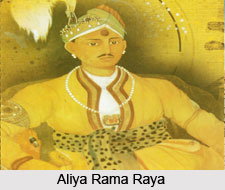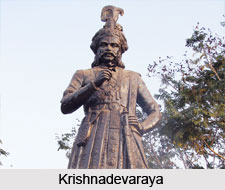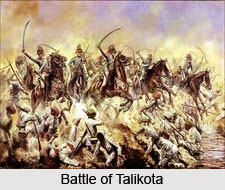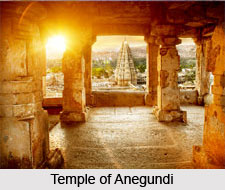 Aliya Rama Raya, also known as Rama Raya was the founder of the Aravidu Dynasty who ruled the Vijayanagar Empire from 1543 till 1565 CE. Rama Amatya, who was a reputed Sanskrit scholar was patronised by Rama Raya.
Aliya Rama Raya, also known as Rama Raya was the founder of the Aravidu Dynasty who ruled the Vijayanagar Empire from 1543 till 1565 CE. Rama Amatya, who was a reputed Sanskrit scholar was patronised by Rama Raya.
Career of Aliya Rama Raya
Tirumala Deva Raya and Aliya Rama Raya were sons-in-law of Krishna Deva Raya, the legendary emperor of Vijayanagar. As per the Kannada language, the term `Aliya` implies nephew and son-in-law. Aliya Rama Raya and his younger brother Tirumala Deva Raya gained significant power during the regime of the ruler Krishna Deva Raya. Aliya Rama Raya was said to be an intelligent army general and a shrewd diplomat who had pioneered several successful campaigns while Krishna Deva Raya was the king of Vijayanagar empire. Following the death of Krishna Deva Raya, Aliya Rama Raya started exercising his influence and power over the internal matters of the kingdom of Vijayanagar. Achyuta Deva Raya, who was the younger brother of Krishna Deva Raya, became the new ruler in the year 1529, after the demise of Krishna Deva Raya. However, Achyuta Raya died in the year 1542, after which the throne passed into the hands of Sadasiva Raya, his nephew.
Sadasiva was just a minor at that time and therefore Aliya Rama Raya declared himself as the royal regent to Sadasiva Raya. Aliya Rama Raya imprisoned Sadasiva Raya immediately after he attained maturity and was about to ascent the throne as a capable ruler of Vijayanagar empire. After Sadasiva was taken captive, Aliya Raya called himself the new virtual ruler and eliminated several faithful servants of Vijayanagar, replacing them with servants who displayed their utmost loyalty to him.  The Gilani brothers were then appointed to his services, who had previously served Sultan Adil Shah as his commanders. This, however, would prove to be a costly mistake which would lead to the Battle of Talikota later.
The Gilani brothers were then appointed to his services, who had previously served Sultan Adil Shah as his commanders. This, however, would prove to be a costly mistake which would lead to the Battle of Talikota later.
Sultanate Affairs during Aliya Rama Raya
While Aliya Rama Raya was ruling Vijayanagar as a regent, the Deccan Sultanates were always engaged in internal conflicts and asked Aliya Raya to be their mediator and resolve their issues. This encouraged Aliya Rama Raya to proceed to the northern parts of Krishna River and seek his territorial expansion, gaining advantage of the disputes amongst the Deccan Sultanates. He had also suppressed the rebellion which was led by the chieftains of Chandragiri and Travancore. Historical accounts have also stated that Qutb Shah of Golconda and the Nizam of Ahmednagar had requested Aliya Rama Raya to support them in their battle against Bijapur. Rama Raya then enabled the Nizam and Qutb Shah to regain the region of Raichur Doab for his benefactors. During 1549, when Barid Shah of Bidar and Adil Shah of Bijapur attacked the Nizam of Ahmednagar, Aliya Raya had participated in the war by supporting the Nizam of Ahmednagar and restored the fort of Kalyana. Again, when the Sultan of Bijapur had invaded Ahmednagar in the year 1557, Aliya Rama Raya had made Barid Shah of Bidar as well as Ali Adil Shah of Bijapur as his allies. Qutb Shah of Golconda and Nizam Shah of Ahmednagar were defeated by the armies of the three kingdoms.  This particular policy of Aliya Rama Raya of constantly altering his sides and changing his allies in order to meet his own objectives motivated the Deccan Sultanates to create their own alliance. Inter marriages between the Muslim rulers were encouraged to resolve the disputes amongst the several Muslim Sultans. Therefore, all the rulers of the Deccan Sultanate unified against Aliya Rama Raya which resulted in the Battle of Talikota.
This particular policy of Aliya Rama Raya of constantly altering his sides and changing his allies in order to meet his own objectives motivated the Deccan Sultanates to create their own alliance. Inter marriages between the Muslim rulers were encouraged to resolve the disputes amongst the several Muslim Sultans. Therefore, all the rulers of the Deccan Sultanate unified against Aliya Rama Raya which resulted in the Battle of Talikota.
Battle of Talikota
In 1565, Aliya Rama Raya headed the battle which was being fought against the Deccan Sultanates which comprised the Ibrahim Adil Shah, Ali Adil Shah and Husain Nizam Shah. This was the famous Battle of Talikota. The army of Vijayanagar was about to emerge victorious in this battle, but the abrupt capture and demise of Aliya Rama Raya spelt doom for Vijayanagar. Vijayanagar was severely conquered and a majority of the regional inhabitants were murdered by the Muslim invaders. The royal family of Vijayanagara was captured and destroyed completely. Thereafter, Vijayanagar was reduced to ruins, which came to be referred to by the name of Hampi.
Aravidu Dynasty
At the Battle of Talikota, Aliya Rama Raya met his end and Tirumala Deva Raya, who was his brother also retreated from the battlefield, to Vijayanagar. The majority of the royal wealth was shifted by Tirumala Deva Raya, and he was accompanied by Sadasiva Raya to Penugonda. It was here that both of them made a bold attempt to restore authority and order to the empire. He then moved the capital to the region of Chandragiri.  Innumerable and important members of the royal family of the Vijayanagar empire were assassinated. Since Aliya Rama Raya enjoyed quite a prominent position at the royal court of the empire though he was not a proper king, his successors came to be known as the descendants of the `Aravidu` dynasty. But, the emperor`s designation was meaningless since the Vijayanagar Empire did not exist any longer, after being mercilessly demolished by the Deccan Sultanates. Keladi, Nayaka, Madurai and Mysore which were significant feudatories of Vijayanagar now started declaring their independence. Some Muslim lords acknowledged the authority of the Bahmani Sultans, and later the Mughal emperors.
Innumerable and important members of the royal family of the Vijayanagar empire were assassinated. Since Aliya Rama Raya enjoyed quite a prominent position at the royal court of the empire though he was not a proper king, his successors came to be known as the descendants of the `Aravidu` dynasty. But, the emperor`s designation was meaningless since the Vijayanagar Empire did not exist any longer, after being mercilessly demolished by the Deccan Sultanates. Keladi, Nayaka, Madurai and Mysore which were significant feudatories of Vijayanagar now started declaring their independence. Some Muslim lords acknowledged the authority of the Bahmani Sultans, and later the Mughal emperors.
The later rulers belonging to the Aravidu Dynasty were devoid of any imperial power, though they were able to enjoy respect in the empire. Powerful rulers like the kings of Madurai and Mysore treated them with great reverence and bestowed gifts to them. The Raya of Anegundi, who hails from the Aravidu Dynasty, is still honoured by the other princes of the country.






































